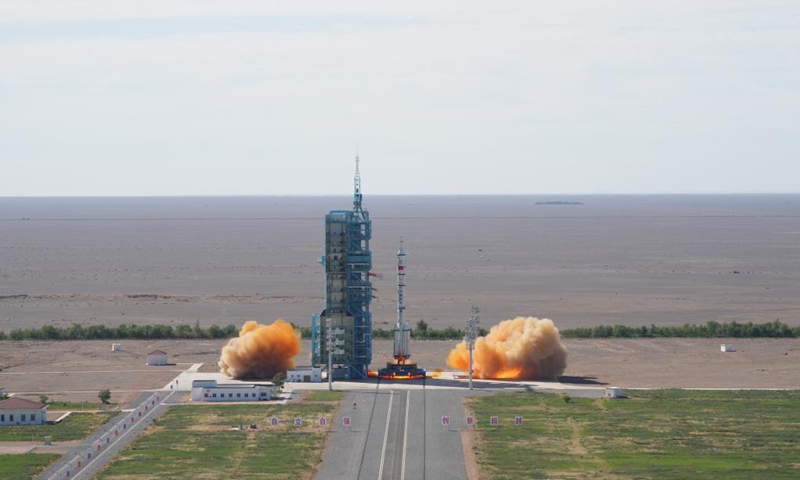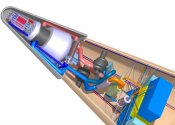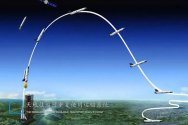You are using an out of date browser. It may not display this or other websites correctly.
You should upgrade or use an alternative browser.
You should upgrade or use an alternative browser.
China's Space Program News Thread
- Thread starter crazyinsane105
- Start date
- Status
- Not open for further replies.
escobar
Brigadier
CAS released a documentary that includes every key moment of the rocket launchCAS Space has seccessfully lauched their first rocket, which is the biggest solid rocket that have ever lunched in China
Congratulations!
View attachment 94174View attachment 94175
AssassinsMace
Lieutenant General
There was a time where in some places the horse was seen as so majestic that laws only allowed white men to be able to ride them. The West worrying and complaining about this is the new high-tech lynching going on here.
Why China will beat them is because first everything in the West cost more to do and secondly in the West someone individually has to profit from it which means it'll cost even more. There's no such thing as a private space company when your primary customer is the US government. Where's all that talk how China will be left behind because it's not private companies behind China space program?
GT's take...
China’s sub-orbital carrier makes 1st successful repeated-use flight, a great step forward in reusable space transportation technologies
By Leng Shumei Published: Aug 26, 2022 01:14 PM

The crewed spacecraft Shenzhou-12, atop a Long March-2F carrier rocket, is launched from the Jiuquan Satellite Launch Center in northwest China's Gobi Desert, June 17, 2021. Photo:Xinhua
China's reusable sub-orbital space carrier made its first successful repeated-use experiment flight on Friday, the developer China Aerospace Science and Technology Corp (CASC) announced. This is a great step forward of China's development in reusable space transportation technologies, the corporation said.
The vehicle, a lifting-body sub-orbital carrier, was reused and launched vertically in the Jiuquan Satellite Launch Center in Northwest China's Gansu Province after receiving inspection and maintenance, the China Central Television reported citing an announcement of the CASC.
It landed stably at an airport in Alxa Right Banner in North China's Inner Mongolia Autonomous Region after finishing a flight in the sub-orbit as planned, according to the announcement.
Song Zhongping, a space analyst and TV commentator, told the Global Times that sub-orbital carriers, which are used for sending payloads to about 100 kilometers above the Earth's surface, could serve a variety of purposes such as ferrying satellites.
The lifting-body and sub-orbital characteristics mean that the carrier has aerodynamic design and can conduct operation in sub-orbit. Such craft has more lifting power, Song explained.
Technologies required for reusable sub-orbital flights are very demanding, as the craft had experienced both the environment in space and that under the Earth's atmospheric influence, experts said.
The latest successful repeated-use flight means that both materials and engine system of China's domestic reusable sub-orbital vehicle can be reused, which is a great technical breakthrough and remarks a technical milestone, Song said.
One of the most noteworthy points of the flight is that the carrier landed in a normal airport, which is more practical and safer, just like US' space plane. China's mastery of such technologies will greatly boost the research into space planes, laying a solid foundation for developing one of our own space planes in the future, Song said.
CASC's reusable sub-orbital carrier made its successful in July. The development is an advanced integration of aerospace and aviation technologies, and "indicates China's transition from a big space-faring nation to a strong one," CASC said at that time.
It had laid a solid foundation for reusable space-Earth transportation technology, representing the country's first step to achieve innovative, independent development in this field, CASC said.
Reusable sub-orbital vehicles are of huge commercial relevance in the future. They can be developed into carriers for space tourism, fast intercontinental personnel and cargo transport, Wang Yanan, chief editor of Beijing-based Aerospace Knowledge magazine, told the Global Times on Friday.
The vehicles can also be used in taikonauts training, according to Wang.
China's commercial space industry has begun burgeoning since 2014 when the nation opened up the space sector to private capital.
In a statement the CASC provided to the Global Times, the CASC said that it was working on a series of reusable space launch and transport systems, which will greatly boost the country's space shuttle capability, lowering costs and empowering future development in this domain.
China’s sub-orbital carrier makes 1st successful repeated-use flight, a great step forward in reusable space transportation technologies
By Leng Shumei Published: Aug 26, 2022 01:14 PM

The crewed spacecraft Shenzhou-12, atop a Long March-2F carrier rocket, is launched from the Jiuquan Satellite Launch Center in northwest China's Gobi Desert, June 17, 2021. Photo:Xinhua
China's reusable sub-orbital space carrier made its first successful repeated-use experiment flight on Friday, the developer China Aerospace Science and Technology Corp (CASC) announced. This is a great step forward of China's development in reusable space transportation technologies, the corporation said.
The vehicle, a lifting-body sub-orbital carrier, was reused and launched vertically in the Jiuquan Satellite Launch Center in Northwest China's Gansu Province after receiving inspection and maintenance, the China Central Television reported citing an announcement of the CASC.
It landed stably at an airport in Alxa Right Banner in North China's Inner Mongolia Autonomous Region after finishing a flight in the sub-orbit as planned, according to the announcement.
Song Zhongping, a space analyst and TV commentator, told the Global Times that sub-orbital carriers, which are used for sending payloads to about 100 kilometers above the Earth's surface, could serve a variety of purposes such as ferrying satellites.
The lifting-body and sub-orbital characteristics mean that the carrier has aerodynamic design and can conduct operation in sub-orbit. Such craft has more lifting power, Song explained.
Technologies required for reusable sub-orbital flights are very demanding, as the craft had experienced both the environment in space and that under the Earth's atmospheric influence, experts said.
The latest successful repeated-use flight means that both materials and engine system of China's domestic reusable sub-orbital vehicle can be reused, which is a great technical breakthrough and remarks a technical milestone, Song said.
One of the most noteworthy points of the flight is that the carrier landed in a normal airport, which is more practical and safer, just like US' space plane. China's mastery of such technologies will greatly boost the research into space planes, laying a solid foundation for developing one of our own space planes in the future, Song said.
CASC's reusable sub-orbital carrier made its successful in July. The development is an advanced integration of aerospace and aviation technologies, and "indicates China's transition from a big space-faring nation to a strong one," CASC said at that time.
It had laid a solid foundation for reusable space-Earth transportation technology, representing the country's first step to achieve innovative, independent development in this field, CASC said.
Reusable sub-orbital vehicles are of huge commercial relevance in the future. They can be developed into carriers for space tourism, fast intercontinental personnel and cargo transport, Wang Yanan, chief editor of Beijing-based Aerospace Knowledge magazine, told the Global Times on Friday.
The vehicles can also be used in taikonauts training, according to Wang.
China's commercial space industry has begun burgeoning since 2014 when the nation opened up the space sector to private capital.
In a statement the CASC provided to the Global Times, the CASC said that it was working on a series of reusable space launch and transport systems, which will greatly boost the country's space shuttle capability, lowering costs and empowering future development in this domain.
It's very interesting that China is still pursuing space plane concepts. Are they the last space power researching space planes in a serious way?A diagram of the reusable launch system
View attachment 96253
Well there's X-37 and Dream Chaser, Skylon too although I'm not sure how serious you would count that.It's very interesting that China is still pursuing space plane concepts. Are they the last space power researching space planes in a serious way?

Space propulsion ushered in nuclear power: my country's first space nuclear reactor passed the acceptance
This article is reprinted from: Science and Technology Daily
Science and Technology Daily reporter Wu Changfeng
On August 25, the "megawatt ultra-small liquid metal cooling space nuclear reactor power supply" led by Wu Yican, an academician of the Chinese Academy of Sciences, successfully passed the comprehensive performance evaluation of the project organized by the Ministry of Science and Technology.
The comprehensive performance evaluation of this project is organized by the High-tech Research and Development Center of the Ministry of Science and Technology. The evaluation experts are from China National Nuclear Corporation, China General Nuclear Power Corporation, State Power Investment Corporation, China Aerospace Science and Technology Corporation, and the Ministry of Ecology and Environment. and Radiation Safety Center, Tsinghua University, China Institute of Atomic Energy, Institute of Physics, Chinese Academy of Sciences and other units.
The expert group believes that the results of this project have formed a set of innovative power supply designs for megawatt lithium-cooled space nuclear reactors with technical parameters at the international advanced level, and built a non-nuclear integrated principle prototype of lithium-cooled space nuclear reactors. The operating temperature is the highest in the world for similar devices. A series of research results have been achieved in software and digital prototypes, key equipment process prototypes, and integrated principle prototypes, which provide an alternative technical route for the research and development of my country's space nuclear reactor power supply, and help promote the innovation and development of my country's aerospace and nuclear energy technology.
After 3 years of hard work, the project cooperation unit has successfully completed the international advanced megawatt-level lithium-cooled space nuclear reactor power supply design scheme and non-nuclear integrated principle prototype, and developed the thermal system analysis, safety analysis, system simulation, reactor Core physics and thermal coupling transient analysis, propulsion orbit design and other software have formed a set of digital prototype of lithium-cooled space reactor concept power supply, developed reactive compensation mechanism, heat exchanger, radiation radiator, liquid metal pump, high-efficiency power generation and penetration Process verification samples of key equipment such as flat and lightweight composite pipe fittings, and conduct performance testing and life prediction.
It is reported that this project focuses on the long-life small and high-power requirements of my country's aerospace deep space exploration, solves the problem of high-power space energy supply and propulsion, and provides inherently safe, intelligent and autonomous control, lightweight, and long-life new megawatt-class small space nuclear reactor power supply The innovative implementation path will promote the continuous improvement of my country's aerospace and nuclear energy technologies and make important contributions to my country's aerospace power.
- Status
- Not open for further replies.

